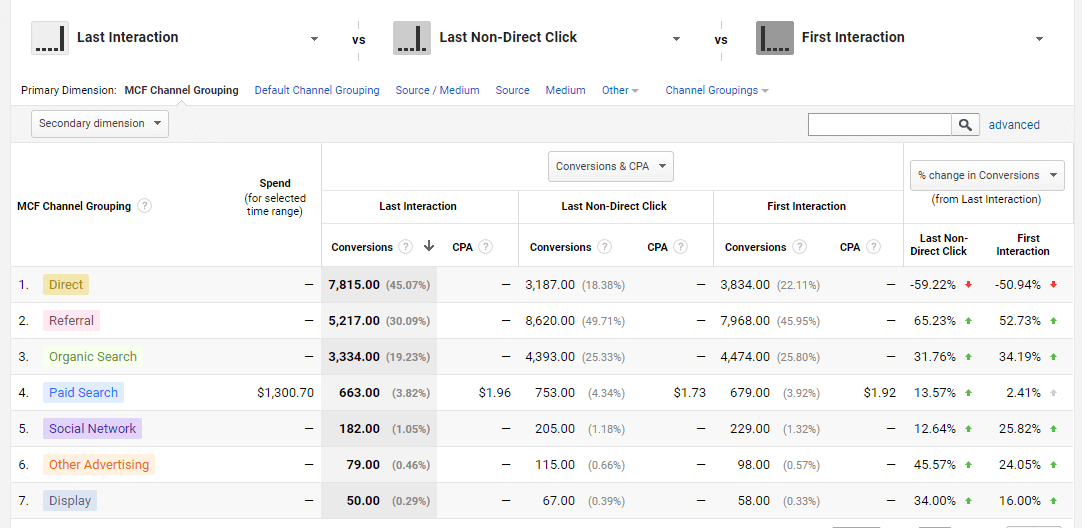Suppose you are a small business owner in your town, to advertise your business you run multiple campaigns through local newspapers and TV channels. Once the customers start pouring into your business and make a purchase, you assign credits to the campaigns for driving customers to the business. This activity, in turn, helps you channelize your advertising expenses and also enables you to monitor your ROI from these Ads.
Now, let’s say your business is online. Attribution Modeling in Google Analytics facilitates you to assign proper credits to the acquisition sources. An Attribution Model is a rule or set of rules, that determines how credit for sales and conversions is assigned to the various channels that contributed at one step or the other in your conversion paths
Different Types Of Attribution Models
The following model diagram, in Image1, can help in understanding the Google Analytics Attribution models –
Image1: Google Analytics Attribution Models
Now let us dig into the details of the attribution models that Google Analytics provides –
- Last Interaction Model:- Assigns the entire conversion credit to the last touchpoint with which the user interacted before converting or transacting
- Last Non-Direct Click:- Assigns the complete credit for the conversion to the last non-direct touchpoint that the user interacted with before converting, this model ignores the direct channel while assigning the credits for acquisition
- First Interaction Model:- Assigns the entire conversion credit to the first touchpoint with which the user interacted in the conversion path
- Linear Attribution Model:- Assigns equal credit to each touchpoint in the conversion path
- Time Decay Model:- Assigns most of the credit to the closest touchpoint in the conversion path, while the touchpoint farthest gets the least credit
- Position Based Model:- Assigns 40% credit to each of the first and last interaction, and the remaining 20% credit is distributed evenly to the middle interactions
- Last AdWords Click:- Assigns the entire credit for the conversion to the first and only click to the Paid Search Channel
Google Analytics, by default, uses the Last Non-Direct Click attribution model, however, users can compare any of the aforementioned attribution models using the Model Comparison Tool in Google Analytics. Apart from the attribution models discussed, you can also create your own custom attribution models keeping one of the aforementioned models as a base.
Image2: Model Comparison Tool
Data Driven Attribution Model
While all the attribution models discussed till now will cater to most of your business requirements, none of the aforementioned models use actual data to assign credits to the various touchpoints in the conversion path.
The Data Driven Attribution model is a feature available only in Google Analytics 360 and uses actual data to generate a custom model for assigning conversion credits to the various touchpoints.
The model not only considers the data available in Google Analytics but also scrutinizes the data from all of the Google products that have been linked to your Analytics Accounts such as AdWords, the Google Display Network, and the DoubleClick Campaign Manager. It also considers the data that you upload via the Cost Data Upload feature. The model uses the Shapley Value solution concept from cooperative game theory to provide algorithmic attribution recommendations for each of the channels defined in your Default Channel Grouping. (Source: Google’s Post on Data Driven Attribution)
Using the Data Driven Attribution Model
The Model Comparison tool allows you to select the Data Driven Attribution Model as one of the models for comparison in your Google Analytics 360 property.
Image3: Using Data Driven Attribution Model in Model Comparison Tool
The Data Driven Attribution Model can also be used as a baseline model when you are trying to create a custom model using the Analytics Custom Model Builder, and hence you can add your own custom rules to the Data-Driven Attribution Model.
Image4: Using Data Driven attribution model in custom model builder
Requirements For Using Data Driven Attribution Model
From Google Support’s post on “Attribution Modeling Overview” , to use Data-Driven Attribution, you must:
- Be a Google Analytics 360 customer
- Have either Ecommerce Tracking or Goals set up
- Meet the minimum conversion threshold in the past 28 days. The current threshold is:
- 400 conversions per conversion type with a path length of 2+ interactions AND
- 10,000 paths in the selected reporting view (roughly equivalent to 10,000 users, although a single user may generate multiple paths)
To view the reports for Data Driven Attribution Model, make sure that you have enabled Data Driven Models under the view settings –
Image5: Enable Data-Driven Models
Once the Data-Driven Models have been enabled, you will be able to see the data in Data Driven Attribution Model under your attribution reports within 7 days.
To conclude whatever I have discussed till now, the Data Driven Attribution Model can provide you with the following benefits –
- The credits assigned by Data Driven Attribution Model to the various touch points depend on data collected during users’ interactions, which adds to the credibility of the model
- The credibility of the model allows you to channelize your advertising and marketing expenses to proper channels and hence helps you drive higher ROI
Interested in knowing more about setting up data driven attribution model for your different campaigns? Get in touch with us or leave a comment below and our team will get back to you.
References:
- Reports shown here are taken from the Google Merchandise Store Account.
- How it Works: https://support.google.com/analytics/answer/1662518?hl=en
- All Model Definitions from: https://support.google.com/analytics/answer/3264076?hl=en







